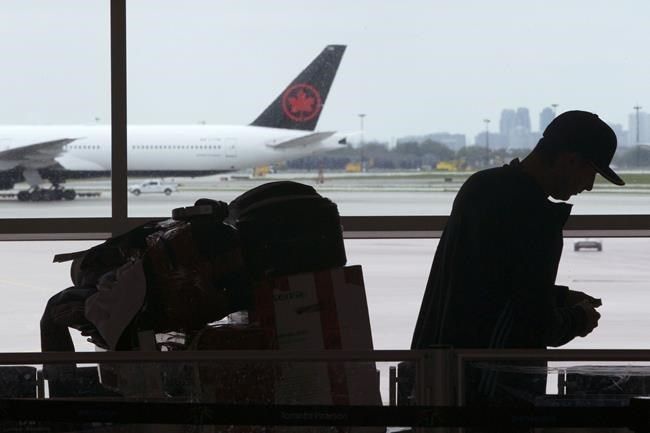New rules aimed at making travel within Canada safer and more accessible for people with disabilities mark a welcome step forward but don't yet go far enough to removing long-standing barriers, advocates said Thursday as the new regulations officially came into effect.
The reforms drafted by the Canadian Transportation Agency spell out rules governing most travel between provinces by air, rail, bus or boat. They do not apply to municipal or intraprovincial travel, which do not fall under the agency's jurisdiction.
CTA Chairman Scott Streiner said the regulations aim to remove barriers that have plagued disabled travellers for years, such as additional fees for accommodations, inaccessible communication in travel hubs and lack of staff assistance for those navigating them.
Advocates flagged many barriers that still remain, noting key changes do not apply to small transport providers or some international travel, but nonetheless hailed them as a notable victory.
"There's big holes still in these regulations that we need to address, but we've got a footing now," said Heather Walkus, who is blind and serves as the head of the transportation committee of the Council of Canadians with Disabilities. "We no longer have to convince bureaucrats of this, this is the law of Canada."
The agency first published the Accessible Transportation for Persons with Disabilities Regulations last summer after two years of consultations with Canada's disability community.
Streiner said the objective was to bring a patchwork of regulations and guidelines, most of which were non-binding, under one mandatory framework that could be broadly applied and enforced with penalties if violated.
The rules, spelled out over more than 200 sections, are sweeping in scope and pertain to nearly all aspects of domestic travel that falls under the agency's purview.
Transport hubs and providers alike now have obligations around accessible communications, noting websites and materials must be provided in a variety of formats and any announcements have to be made in both visual and audio form.
Streiner said the regulations also include a clear definition of what qualifies as a service animal, buffer zones and other protections for people living with severe allergies, requirements for staff to provide curb-to-gate assistance for passengers needing support, rules around the handling of wheelchairs on transport vehicles, and guidelines on making on-board entertainment accessible for all.
Some of the rules also reflect the fact that some disabilities are episodic in nature, a fact rarely addressed under the previous regime.
"The simple fact that we have all of these provisions in one place, and they can all be the subject of complaints from travellers with disabilities, and they can all be enforced, that is the single biggest breakthrough," Streiner said, noting violators would receive a warning for initial infractions and could face penalties of up to $250,000.
Streiner cited the expansion of the Agency's "one person, one fare" policy as among the biggest advancements in the new regulations, a view shared by disability advocates.
The policy, which was previously only in effect on certain airlines, allowed a disabled person to pay for only one seat even if they require more than one as a disability accommodation. The new regulations now make the policy mandatory across all transportation modes, not just select airlines.
Terry Green, an Ottawa resident living with multiple disabilities, lauded the agency for applying the policy more broadly.
But he criticized the exemption that will prevent several other key measures from taking effect on Thursday as planned and instead push them back to Jan. 1, 2021. These include several guidelines for accessible communication and on-board entertainment, as well as rules allowing carriers to retain medical documentation, thus saving passengers from the potential hassle of completing the same forms each time they travel.
Green said transport providers, which have been aware of the new regulations long before the advent of COVID-19, should not use a global pandemic as an excuse to delay long-needed action.
He also criticized some of the new rules, such as those that set limits on the size of wheelchairs that can be allowed on board. He noted that constant changes in medicine and technology mean the demographic targeted by the regulations will keep evolving, but rigid constraints won't allow the agency to keep pace.
"What is considered good accessibility today is not necessarily what would be good accessibility tomorrow," he said. "I think some part of these regulations that are coming into effect aren't worded flexibly enough to capture that."
The CTA noted that it has the power to order transport providers to take steps that go beyond the new rules, which could allow it to adapt to evolving technology.
But Green's concern is shared by Allen Mankewich, a wheelchair user from Winnipeg. More pressing for him, however, is the degree to which employees of the travel industry will embrace the new rules and the inclusive spirit they're meant to promote.
Mankewich said he's encountered discriminatory treatment while flying more than once, including on one occasion when an airline employee tried to bar him from flying without an attendant on the grounds that they had had unspecified trouble with disabled passengers in the past.
"It ... was completely unnecessary," he said. "It reflects a misunderstanding by some employees about what their own policies actually are."
Mankewich and other advocates hope future changes to the rules will allow wheelchair users to travel in their mobility devices on vehicles rather than storing them in baggage compartments where they're highly prone to damage.
Streiner said such discussions are underway, as well as considerations around expanding "one person, one fare" to international travel and adopting way-finding technology in travel hubs to help visually impaired travellers with indoor navigation.
This report by The Canadian Press was first published June 25, 2020.
Michelle McQuigge, The Canadian Press
Note to readers: This is a corrected story. A previous version said the new rules did not apply to any international travel. In fact, international travel is covered under some of the regulations.



